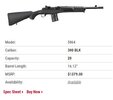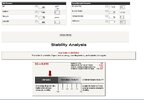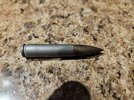GrumpyOlGuy
Member
- Joined
- Aug 26, 2018
- Messages
- 15
(Reviving a thread from a few years ago) There has been ton of discussion about M1 Carbine (good: Handy, light); bad: under-powered, weak, short-ranged). The single biggest mistake made by Winchester was not using a pointier, higher ballistic coefficient bullet. Going from the round nose (BC ~0.178) to a pointy bullet (BC ~0.275 to 0.300) would have increase the effective range by about 150 to 175 yards. I consider the as-built Carbine to have an effective range of about 250 yds (where the bullet had about the energy of a 9mm Parabellum (115gr) at the muzzle). At 450 yds, the high BC Carbine bullet would have the same energy as a .38 Special +P at the muzzle. At 225 yds, its a .357 magnum (muzzle energy), 75 yards further out than with a standard Carine round (equiv at 135 yds). Who could argue with that for power?
If a 110 gr, 0.275 BC bullet were used, the bullet at 400 yds would have the same energy as the 9mm/115 muzzle. At 375 yds it would have the same energy as a 230 gr .45 Auto at the muzzle. I think many people would find that energy satisfactory. (All calcs from standard ballistics calculators).
The could have been done any number of ways (bottle-necked case, slightly longer action (~ 0.2 inches) to accommodate the longer bullet). Two bad this wasn't done at the time - a much more effective weapon (with a 150% increase in effective area covered) could have been had for nearly no additional effort. I know, i know -- it was only to be a replacement for a pistol... that kills stuff at 250 yds.
Oh, well.
If a 110 gr, 0.275 BC bullet were used, the bullet at 400 yds would have the same energy as the 9mm/115 muzzle. At 375 yds it would have the same energy as a 230 gr .45 Auto at the muzzle. I think many people would find that energy satisfactory. (All calcs from standard ballistics calculators).
The could have been done any number of ways (bottle-necked case, slightly longer action (~ 0.2 inches) to accommodate the longer bullet). Two bad this wasn't done at the time - a much more effective weapon (with a 150% increase in effective area covered) could have been had for nearly no additional effort. I know, i know -- it was only to be a replacement for a pistol... that kills stuff at 250 yds.
Oh, well.




